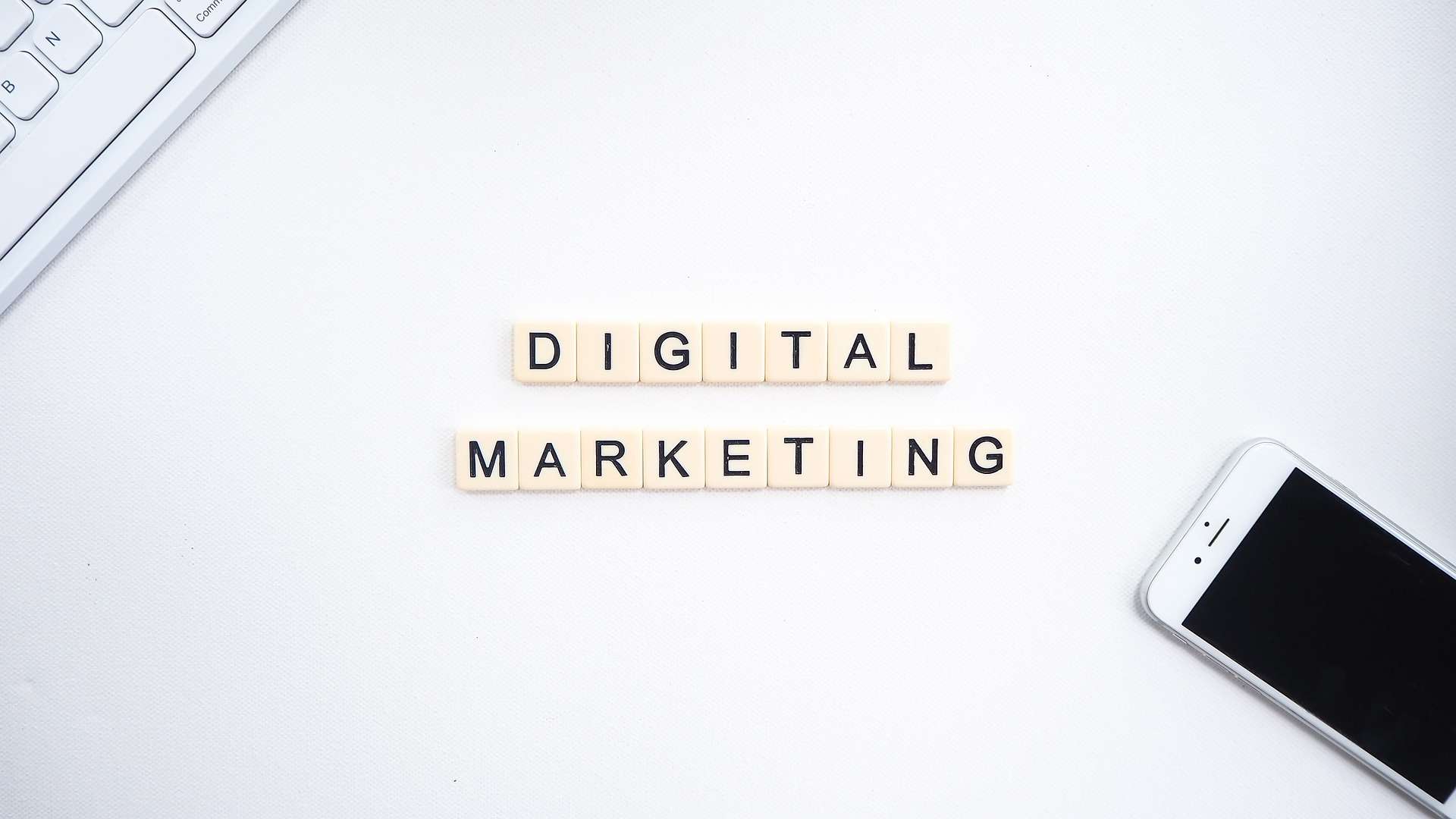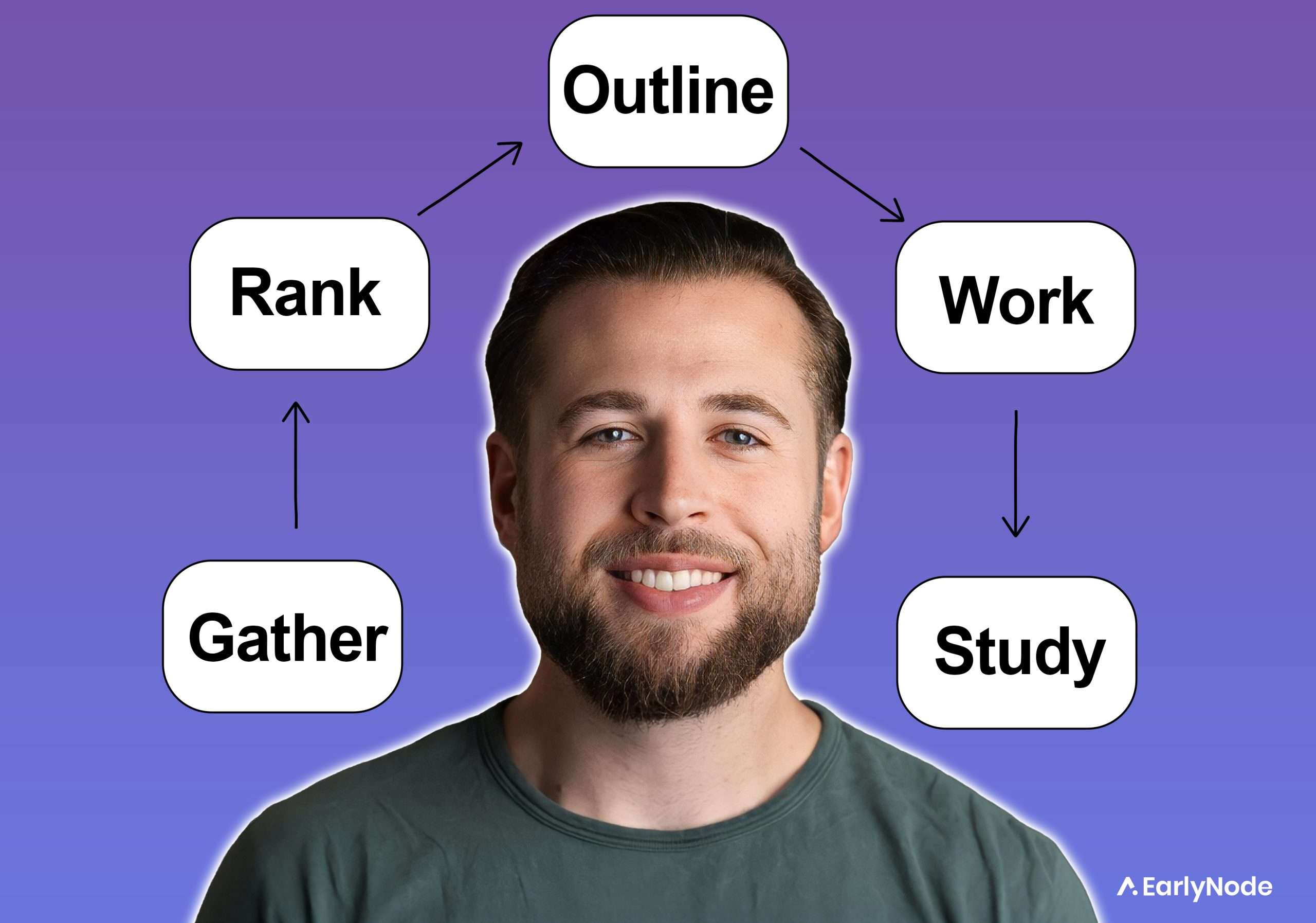30 B2B SaaS Marketing Best Practices
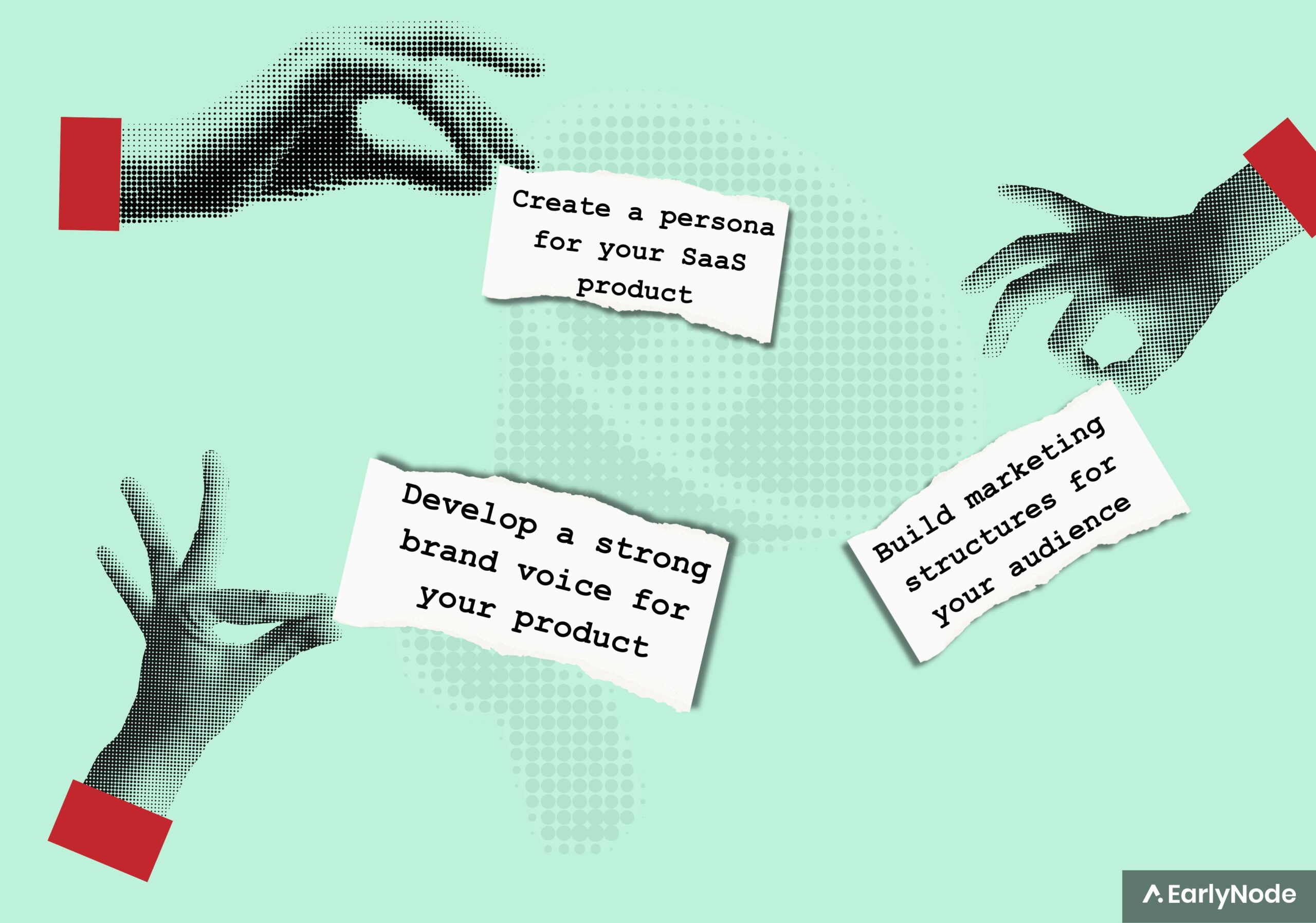
What comes to mind when you think about successful SaaS companies like HubSpot, Salesforce, and Zoom? You probably think about how these companies were able to scale their product growth and set high profitability standards.
The answer is in three words: Product. Marketing. Data.
But let’s talk about marketing. Building a SaaS startup may be exhilarating, but getting people to use, fall in love with, and refer others to your SaaS product? Oh boy, that’s the real chore!
And most B2B SaaS companies understandably consider this daunting. But the key is identifying foundational SaaS marketing best practices that will drive acquisition, activation, retention, revenue, and referral for your product.
This article distills 30 B2B SaaS marketing best practices for founders and marketers, including positioning and onboarding flow optimization, to boost momentum and scale their business.
TL;DR
- Set up your marketing basics: Create a persona for your SaaS product. Every other marketing strategy you’re applying to grow your SaaS revolves around how you’ve created and mapped your target audience, built an Ideal Customer Profile (ICP), and map out inbound content to reach them.
- Brand building and positioning best practices: Develop a strong brand voice for your product, always communicate your unique value proposition, and participate in or host webinars if you’re a B2B SaaS company, and grow your recognition in your industry.
- Content marketing best practices: Connect the dots in your content creation process with omni-channel marketing, research and publish industry reports, and utilize pain-point SEO to scale your content marketing efforts. Don’t forget to set up product analytics to track how your users interact with your product.
- Customer acquisition best practices: Continuously A/B test different aspects of your website and landing pages or in-app features, differentiate your product especially if you operate in a saturated market, and create/publish case studies showing how other users are using your product.
- Customer activation best practices: Build marketing structures for your audience. Prioritize customer success strategies, personalize the onboarding experience for your users, make your pricing clear, and experiment with different ways to reduce the time-to-value.
- Retention and growth best practices: Always collect customer feedback—positive reviews, churn reviews and passives—to learn what features your customers love using, and don’t like using; what they wish they had, or what factors would drive your passive users to begin to recommend your product. Upsell and cross-sell adjacent products, and periodically run customer appreciation programs to drive retention for your SaaS.
- Referral best practices: Incentivize your users to share their experiences using your product on SaaS review sites like G2 and Capterra, integrate viral marketing loops in your SaaS product, and experiment with milestone rewards for your users when they complete certain actions.
- Revenue growth best practices: Define the most important growth metric for your SaaS, i.e., your North Star Metric (NSM). Once you know this, targeting other metrics for growth that contribute to this NSM becomes easier. Adopt a product-led approach for your SaaS; product-led companies are projected to be twice as likely to achieve 100% growth YoY compared to sales-led companies. If you’re currently operating a sales-led motion, consider adopting a dual approach and integrate product-led marketing practices for your SaaS.
- Product launch and adoption best practices: When launching new products/features, try to experiment and choose the right channels for your delivery or announcement. Avoid giving discounts/giveaways to drive product adoption especially if you’re not profitable.
- Long-term success and scalability: Build robust customer success, support, and community initiatives to maximize renewals and upsells for existing accounts.
Set up your marketing basics
Before you think about running marketing campaigns and making big spends, it is vital to get your foundation right. Setting customer targeting parameters for your SaaS is crucial for identifying the product’s intended audience and ensuring clarity in other marketing aspects.
#1 Define your target audience
Defining your target audience is crucial for effective marketing strategies, and creating an ideal customer profile helps focus on the specific market so you can achieve brand resonance faster. Eliminate clutter and follow this simple process.
Create user personas
User personas represent the employees at your target B2B companies who actually use your SaaS product day-to-day. They differ from buyers, who make the purchasing decisions at the corporate level.
For example, you operate a B2B SaaS cybersecurity ed-tech product that trains tech company staff members and offers industry-recognized certificates; let’s call it Pied Piper.
Your user persona should contain their job title, company type/industry, and geography. In this scenario, the user personas may include cybersecurity professionals, IT database administrators and data engineers (job title) working in technology companies (industry) in the United States (geography).
After identifying your users on a surface level, you then want to get into the trenches and craft detailed personas for your core expected user types, including relevant demographics, attitudes, behaviors, psychographic information, and customer pain points.
Ask questions like:
- What do they want to achieve? Advanced cybersecurity education to be able to do their jobs better? Better certificates to move up the career ladder?
- Where do they work?
- What is their job title?
- What are their biggest frustrations and motivations with finding advanced cybersecurity courses?
- What is their role in the buying process? (E.g., they recommend the product to their bosses)
- What certifications are they looking for?
Pro tip: Don’t focus on your product or features – focus on the specific goal your target user wants to achieve or problems they want to solve.
Define buyer personas
Buyer personas represent the decision-makers who control purchasing budgets at your target companies. Sticking with our example for the ed-tech product, our ideal buyers may be chief technology officers (CTOs), data engineering heads, IT directors, or HR managers who pay for their teams to use Pied Piper.
Like user personas, when defining your buyer personas, ask questions like:
- What are their responsibilities and initiatives? (Their priorities; e.g., they want to improve the quality of professional development programs staff at their company receive, they want to save cost on employee training)
- What business goals are they focused on? What does company-wide success look like to them if the problem is solved? (Drive more revenue? Reduce talent turnover?)
- What solutions have they previously tried? What is their workaround now?
- Where do they get information about solutions? What events do they attend?
Pro tip: Buyer personas are usually all about their business. Focus on aligning your solution with their business needs.
Define your Ideal Customer Profile (ICP)
An Ideal Customer Profile (ICP) focuses specifically on identifying your best-fit customers. These are organizations and buying teams that have the most need for your product, are most likely to purchase, and see value from using it.
As a rule of thumb, your ICP is the combination of the biggest problem(s) you’re solving right now and how helping to solve that defined problem takes you from zero to one.
When crafting your ICP, ensure that:
- They make up the largest sector of the market(s) you’re targeting
- They likely have the most emotional connection with your product
- They have the buying power to take your product from zero to one
For Pied Piper, this group might be CTOs at mid-sized financial technology companies.
The purpose of defining your ICP is to help you determine which of the personas to prioritise, especially when you’re early-stage and don’t have the resources to market to, or build for every single persona.
Segment your customer base
In cases where you have an enormous potential user base, break them down into segments – E.g., by industries, by occupations, by job functions, etc.
Creating a customer segment helps you create laser-marketing materials that target these users.
Pro tip: If you’re a small B2B SaaS business and cannot afford to target every segment, prioritize your biggest market before expanding. Otherwise, use different landing pages to create use cases for your target customer segments.
#2 Build content specifically targeted at different personas created
After defining all your personas, you’d have completed a critical aspect of your SaaS marketing strategy. Creating content for different personas involves a tailored approach considering each target persona’s unique characteristics, needs, and preferences.
For example, Loom positions itself as a “video recording tool” – already a broad use case. So it does an excellent job in capturing specific use cases for different industries and teams that will find their product helpful; like customer support teams for creating demo videos, product managers for creating product teardown videos, and QA engineers for feature testing. They create different types of content that specifically targets their distinct audience types.
Mapping your content to specific target personas & customer segments is the best way to create an inbound marketing strategy for your B2B SaaS.
SaaS best marketing practices for brand-building and positioning
After nailing who the biggest assets to your business are, the next step is to define your positioning playbook. At its core, your positioning communicates why you stand for what you stand for.
#3 Develop strong brand voice
Your brand voice is your marketing signage. If done right, it is the most recognizable thing about your brand and how you communicate.
MailChimp, for example, adopts a friendly tone in all its marketing communications. Harley Davidson’s style of communication has been compared to rebel branding. And technology innovators, Apple, are only identified with one word – inspiring.
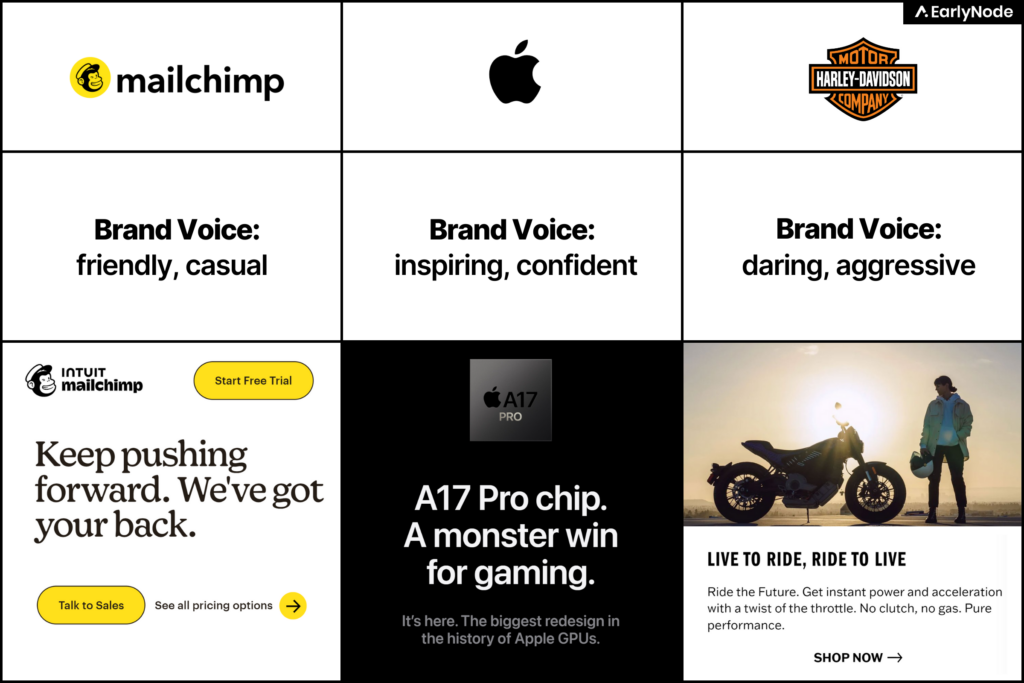
Creating a unique voice for a SaaS startup can be challenging, often requiring iterations. Understanding your audience and their communication style is crucial.
For instance, our B2B ed-tech product targeting IT professionals and high-growth companies can create a powerful connection with customers by adopting an empathetic, confident, and encouraging voice that aligns with their vision and goals.
#4 Clearly communicate your unique value proposition
What is one thing about your product that customers should care about? Think about it as the biggest reason your product exists in the market.
This should form the core of your marketing. Be clear with your unique proposition: why should your target audience pick you over your competitors?
Slack does a great job with their value proposition. Slack says it is a software “built for (team) productivity.”
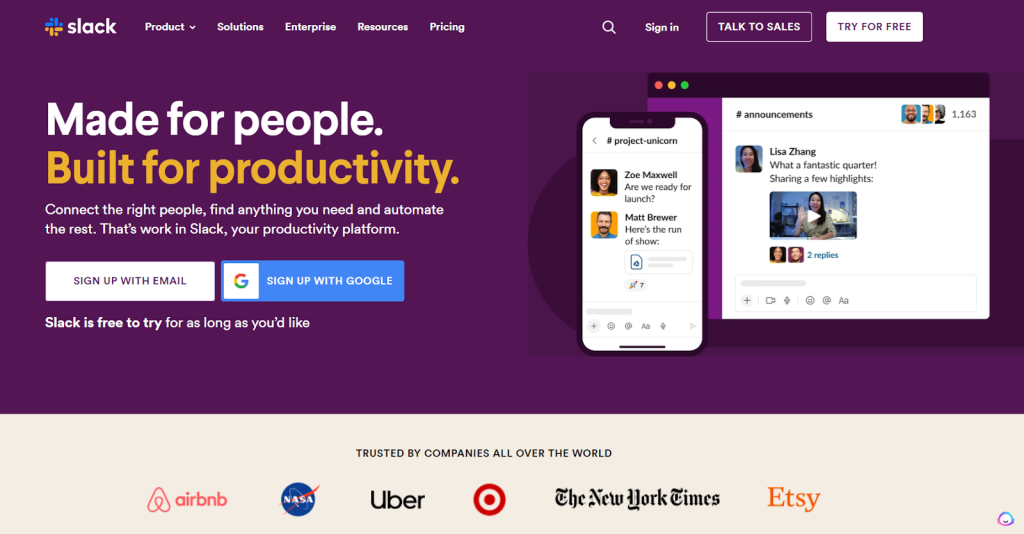
When you craft your proposition, use this chiefly across bold areas of your marketing channels to ensure you’re constantly saying what your product is (or isn’t) to your customers. E.g., landing page, above-the-fold copies, marketing materials, and across stories used to sell your brand.
Pro tip: Keep it real with your unique proposition and ensure you deliver on all fronts of your promises. Else, you risk losing customer trust and confidence, possibly generating churn.
#5 Find your area of differentiation
To differentiate your product, service, or brand from competitors, identify meaningful gaps in your market that competitors are ignoring. Build expertise in these areas, and aim to make your customers perceive you as a specialist product.
HubSpot and Salesforce are two legendary SaaS companies that have utilized this differentiation technique.
Salesforce differentiates its CRM suite as a “Sales Engagement” tool.

On the other hand, HubSpot ranks #1 for the keyword, “marketing automation,” and sells itself as a marketing automation software.

Both companies play in the CRM market, but they’ve carved out sub-markets in their playing field to rule over and differentiate their products.
#6 Sponsor/host industry events that focus on topics your brand cares about
B2B SaaS businesses can establish market leadership by hosting industry events that align with their brand themes. Salesforce, for example, hosts the Dreamforce event, attracting cloud and cybersecurity experts. This helped Salesforce become a top Cloud B2B SaaS company.
Now, we’re not saying every SaaS founder has to fork out the dollar bills to make this happen as spectacularly, but hosting local industry events, even on a small scale, allows SaaS founders to educate people on important topics that concern their brand.
Pro tip: If you’re still a growing startup, consider co-sponsoring relevant industry events instead. This way, you get recognition from putting your logos on billboards, backdrops, and flyers.
SaaS best marketing practices for lead generation
Generating leads is crucial for SaaS businesses. More leads mean higher conversions, even with a low conversion rate. Here are some lead generation ideas:
#7 Leverage webinars and online events
Hosting webinars and online events is a great way to stand out as a leader in your market. It is an effective way to build brand authority, generate leads when you host industry experts to discuss industry topics, or even target conversion metrics when you host Ask-Me-Anything (AMA) webinars.
One SaaS example we love is Zoom‘s Zoomtopia event. They use this event to showcase their product features and re-state their position as remote work pioneers.
#8 Optimize your website with clear descriptions and call-to-action (CTA) buttons
CTAs become truly powerful only when combined with excellent descriptive writing. Simply asking users to do something is not enough.
One example we love is Outseta. The brand does so well in describing the key value you get from using the tool—monetize your website.
Keep it catchy and aim to communicate one single element about your business here. Then, map this value element to those who you have identified as your best customers.

Look at this example:
Outseta’s landing page headline ⇒ All-in-one membership software
Body copy ⇒ Outseta gives founders the tools to monetize their website, SaaS product, or online community.
Founders who have websites, SaaS products, or online communities = Outseta’s best customers.
Pro tip: Use pop-up forms on your website to generate more leads for your business. But be careful not to ruin the experience for your customers with these. Tone it down and set a considerable amount of time before your modal pops up.
Best content marketing practices for SaaS companies
As a SaaS company, there’s no denying that content marketing is one of the biggest assets you have. So, it is important that you make the most of it. Here are our best strategies.
#9 Create an omni-channel content marketing system
Omni-channel content marketing involves optimizing channels like SEO, email marketing, and social media to ensure consistency across all channels.
Creating distribution loops with these channels help to gauge this and be in control. A simple distribution loop might look like this:
Create a blog post ⇒ Optimize your infographics and images used in the blog for image search ⇒ Share content in your newsletter emails⇒ Repurpose bits of this content to share on social media channels ⇒ Create videos based on this blog for video-sharing platforms like YouTube
This way, you’ve devised a simple distribution model for omni-channel content marketing. And you’ve done so with minimal effort.
Pro tip: Use organic social media as part of your B2B marketing channels to create awareness and consideration for your product.
#10 Create industry reports
Building industry reports is a great way to position your SaaS organization as a thought leader. This strategy even works wonders when you want to dominate a new sub-market.
HubSpot is the perfect illustration to show that this strategy works. For example, their State of Marketing report brought in over 1k traffic so far, according to Ahrefs, and this is just one of their reports. This strategy helps them grow their authority and brand trustworthiness due to the quality they’ve constantly distilled.
Pro tip: The real branding juice is in creating quality industry research and operating your SaaS as a media company.
#11 Use pain-point SEO to drive buyers
Popularized by Grow and Convert, “pain-point SEO” means targeting users with buying intent and creating content that meets their needs. It’s like walking into an exclusive fashion event and pitching your services as a top-class tailor.
There are chances that the top-of-funnel SEO topics you’re targeting have all been gobbled up by bigger brands. Instead of targeting keywords based on general interest, focus on buying intent keywords that indicate that searchers are ready to purchase your SaaS product.
For example, keywords like:
⇒ “best cybersecurity training platforms for employees” = comparison keyword
⇒ “[specific brand] vs [competitor]” as in “Pied Piper vs KnowBe4” = product comparison keyword
⇒ “how to do X” = Job-to-be-Done (JTBD) keyword
⇒ “how X solved Y problem” = case study keyword
To implement pain-point SEO, work your way backward. Instead of going the traditional route and finding high intent–low competitive keywords, start with customer pain points. What is your customer’s biggest pain point? Create content around that pain point to sell your product.
Note: Pain-point SEO articles typically do not generate high traffic like top of the funnel (TOFU) keywords but have more conversions.
SaaS best marketing practices for customer acquisition
Let’s discuss customer acquisition practices you can use to achieve sustainable growth for your SaaS.
#12 Define your go-to-market (GTM) motion
One of the key go-to-market decisions SaaS companies face is whether to adopt a product-led or sales-led customer acquisition model.
A product-led approach focuses on designing self-service experiences that allow users to experience core value without intensive sales interactions. Companies like Slack and Zoom have thrived with this model.
However, a high-touch sales process is still crucial for some categories to open doors and customize complex enterprise deals. Leading CRMs like Salesforce leverage their sales teams to match solutions to customer needs precisely.
The right choice depends significantly on average deal sizes and product complexity. For many earlier-stage B2B startups, a product-led model allows rapid iteration and flexibility. However, developing sales capabilities can be invaluable to support expansion revenue and larger contractual commitments over time.
#13 Create relevant case studies
Case studies are storytelling tools that showcase how a SaaS product has helped real customers solve problems and achieve goals. They provide detailed examples of how the software has delivered tangible results for their business.
For instance, Pipedrive has a comprehensive case study section sorted by industries and locations. It showcases how its CRM platform boosts sales productivity and pipeline growth.
Case studies establish social proof and credibility. And this allows prospective customers to see how users solved similar problems before trying out your product.
Pro tip: If you cannot collect case studies from existing customers (or have none yet), use fictional scenarios and guides as use case examples.
#14 A/B test your website and landing page
If you run a multi-product SaaS company, you will likely target more than one user segment for your business.
Build two versions of your landing pages with varying elements such as CTAs, headlines, images, etc. If you have the budget for it, run conversion ads to test the response rate of customers to both pages.
- Draw out an inference from your ad performance, and
- Analyze which landing page style resonated with your audience.
With this knowledge, optimize your website with those elements that made the biggest impact. A/B testing is a continuous process of refining your website to reach your target audience and acquire best-fit customers.
SaaS best marketing practices for customer activation
Customer activation refers to the specific actions you’ve defined for your users to become “active.” For example, Slack defined activation as “having a certain number of users—usually three—in the product and having them send and receive approximately 50 messages,” according to Fareed Mosavat, former Slack Director of Product. Jira defines its own as when a user creates a ticket.
As a tip, define your customer activation metric as that activity your customers take when they first find value in your product. Here are our favorite SaaS marketing trends for customer activation.
#15 Set up product analytics
You’re always on an expedition as a product marketer or solo SaaS founder. Product analytics provides the roadmap necessary for exploring and reaching your goals.
Ensure you have product analytics set up and that you’re targeting all the metrics indicative of your growth. You can analyze your performance using insights from tools like Google Analytics, Mixpanel, Amplitude, or Heap.
These tools help you understand what’s working and what isn’t. This information allows for quicker, more informed decision-making.
#16 Prioritize excellent customer support
According to a McKinsey report, 70% of buying decisions are based on how your customers feel they’re being treated. Another statistic in the report revealed that 75% of online customers expect to receive help from customer support in five minutes.
Embracing and investing in rich customer experiences will significantly help you improve customer activation. This means ensuring that your support teams (both human and automated) are well-trained, accessible, and capable of resolving issues.
#17 Optimize your customer onboarding process
SaaS companies today use different onboarding flows such as the use of modals, checklists, tooltips, and product tours. Onboarding drives activation.
SaaS companies typically utilize a single or a combination of several onboarding flows. Outseta, for example, uses activation checklists.
SurveyMonkey uses a combination of feedback forms and interactive tutorials (product tours) to collect attribution information and lead new users to create their first survey.
Pro tip: Keep it simple and tailor-fit your onboarding process to specific users to avoid churn. Always ask yourself: will this help my users unlock value using my product? If it doesn’t contribute to this overarching goal, take it off.
#18 Continually experiment more ways to reduce product’s TTV
TTV means time-to-value; the metric shows how long your users take to reach their “aha moment” when using your product. Ideally, this number should be as low as possible.
The quicker your ideal targeted user uncovers gold from using your product, the better. This means that your product takes their pain away in x minutes. And in a SaaS market rife with competition, you don’t want to complicate things for your users.
As a tip:
- Make your onboarding process as short as possible.
- Make your platform self-serve.
- Eliminate unnecessary data collection that doesn’t directly impact your marketing goal. Even better, delegate those data collection actions to product analytics tools.
SaaS best marketing practices for retention & growth
High user retention is an indicator of how well your customers are enjoying your service.
#19 Collect customer feedback
Customer feedback makes or mars your business. Periodically conduct customer surveys and interviews to understand:
- Why your customers chose you, your competitor, or no one at all (win-loss interviews)
- Why your customers canceled their subscription (churn surveys)
- What feature your customers enjoy the most and cannot do without (product-market fit)
- How likely they are to recommend your product (net promoter score)
- What needs to improve about your product to get them over the line as supporters
Engaging with customers regularly helps identify areas for improvement and correct positioning errors.
For example, you might learn through churn surveys that users chose your product because they thought it could solve x problem for them when it could not. This knowledge will help you adjust your positioning to match the right audience type.
Pro tip: In the case of retention, you cannot afford to joke with win/lose interviews. Consider doing this every six months and aim to interview ten people. Make sure your selection has an even spread among the wins and losses. E.g., interview five win cases and five loss cases.
#20 Upsell and cross-sell relevant products and features
If you operate a suite of B2B SaaS products, consider packaging them into one or different services and offering them to specific customer segments.
Adobe perfects this technique with its signature “Adobe Creative Cloud” offering. This product tier targets creative professionals in general. But then, Adobe does something unique by pairing some of its products into bundles and selling them to specific kinds of “creatives.” For example, its photography tools (Lightroom, Photoshop, Express, and Stock) combine to target photographers and video editors.

Another way to consider upselling and cross-selling is to offer your product as a bundled service. For example, Intercom offers live chat and other customer engagement services as a single bundle. This gives users more options in one bundle than paying individually for each product.
However, if you don’t sell complementary products like Intercom or Adobe, create low-utility services around the main product, which customers will find helpful. Then, upsell them on your main service.
As a B2B cybersecurity ed-tech product, create smaller products around your main solutions. Offer industry-standard assessments to company staff to gauge their cloud-based solution skill level, sell this as an entry service, and upsell your tech solutions to companies.
#21 Optimize your pricing page for clarity
B2B pricing strategy is a crucial aspect of SaaS marketing because providing clarity on your pricing details drives faster decision-making.
Paddle’s article on pricing changes says that subscription-based businesses are missing out on as much as 30% growth because they haven’t optimized their prices.
Here are five tips to help you optimize your pricing strategy:
- Conduct a price survey interview with your users. Find out how much your supporters, passives, and detractors are willing to pay for using your service.
- In your survey, try to find the lowest price that might make your product seem low-quality to users. Also, figure out a high cost but still something they can pay for, and identify where it’s too expensive for them to keep using your service.
- Match their responses to different industries that make up your ICP.
- Use conjoint analysis to get your best price region; these are prices your users can comfortably afford. This will help you set a price that looks right and is still affordable.
- Tailor your prices to different customer segments based on their needs and willingness to pay.
#22 Run customer appreciation campaigns
Celebrate special customers through appreciation campaigns. Here, you can reward customers who have achieved certain usage milestones with your product. Rewards like this can create word-of-mouth referrals, increase loyalty, and attract new customers.
Examples of customer appreciation programs include special discounts, exclusive access to new products or services, personalized gifts, or other defined loyalty programs.
Spotlighting users is another great customer appreciation strategy for SaaS brands. Simply featuring customer success stories and profiles on your platforms shows recognition and makes customers feel valued.
Pro tip: Prompt these users for reviews at their highest moments of euphoria.
#23 Reward users for completing tasks or reaching milestones
Incentivize users when they reach milestones or complete defined tasks. This encourages product stickiness and gives your users a reason to keep returning to your product.
Rewarding your users for completing tasks might take different forms. You can offer in-app benefits like virtual high-fives, badges, usage points, access to premium content, and feature unlocks. Little reward gestures like these motivate users to continue using your product.
For example, Duolingo offers users gems when they complete language lessons. These gems allow them to purchase streak freezes and power-ups.
Dropbox used this strategy when they newly launched; it asked users to invite their friends to get more cloud storage space.
SaaS best marketing practices for referral
Take advantage of these techniques to create referral opportunities for your product.
#24 Optimize opportunities for viral marketing loops
Provide incentives for users to share your product with their network. The key is creating shareworthy content and calls-to-action that incentivize your audience to actively promote your products to their own networks.
Here are some ideas when doing this:
- Make the content shareable; consider incentivizing users to share.
- Make viral features like quizzes, generators, and games to encourage participation and sharing.
- Experiment with content that evokes emotions like humor, surprise, inspirational stories – they’re more likely to be shared.
Focus first on understanding what makes specific content resonate enough with your target audience that they feel compelled to actively pass it along. Emotional impact often matters more than hard product specs.
Spotify’s Wrapped campaigns go viral because of their high shareability and emotional connection.
#25 Collect user testimonials for social proof
It’s simple psychology: when potential customers see that other customers have had positive experiences using your product, they are more likely to trust your product.
Offer incentives to existing customers to write you reviews on websites like Capterra or G2. Ask for testimonials from customers. Where you get positive reviews, thank the customer for taking the time to leave a review. Where you receive a negative review, make sure you address this politely.
Document your learning and observe why customers are leaving negative experiences and what you can fix to solve that problem.
SaaS best marketing practices for revenue growth
Marketing is crucial to stay relevant, but revenue is vital for business survival. Your SaaS marketing strategy should consider revenue metrics to stay relevant and focus on micro-goals that drive revenue. If you’ve missed the mark, realign your priorities to stay on track.
#26 Define your North Star Metric
Typically, the North Star Metric (NSM) defines your users’ aha moments, activation rate, and engagement frequency. It functions as the strategic metric that aligns with all company growth activities.
This directly reflects customer value and the company’s long-term success. For example, Shopify uses active merchants as its NSM; Asana uses weekly active subscribers; Airtable uses number of weekly paid users.
Defining your North Star Metric early on in the business operations process ensures you’re not losing sight of what real growth means for your business.
Pro tip: Tie your product’s NSM to a specific, business-critical entity.
#27 Track the most important metrics to your product’s business model
After defining the North Star Metric, it’s time to determine other goals that contribute to the growth of your North Star Metric.
For example, a SaaS company targeting a %MoM (month-over-month) increase in MRR will target more bottom-line metrics that aim at revenue growth, like average revenue per customer (ARPC), customer lifetime value (CLV), and marketing-qualified leads (MQLs) generated per acquisition effort.
Here’s YCombinator’s guide to help you define your North Star Metric.

SaaS best marketing practices for product launch & user adoption
Best marketing strategies we live by for doing product launches and creating user adoption models include:
#28 Choose the right channels for launches
Launching the perfect product or feature in the wrong channel may be catastrophic. So here’s what you want to do to announce features to boost product adoption for your SaaS:
- Know your audience
- Where you can find them
- What content types they usually consume
- Weigh in on how likely they are to see your product
- Create content types that match their expectations
- Factor in budget. Some channels may be more expensive than others to launch your product
- Measure the channels projected to land the best ROI and pursue
- Check where your competitors are successful and factor in those channels
- Be ready to adjust your strategy (or product) based on feedback
#29 Steer clear of discounts and giveaways
Discounts are ineffective for long-term growth and only benefit users who may not care about your brand. Instead, offer in-app rewards to prompt more usage of your products or reward special kinds of users differently (loyalty rewards).
If you decide to run discounts and giveaway campaigns, you must understand that all the buzz you generate from this will be short-lived. Giveaway campaigns cause a huge spike in pseudo-growth before everything returns to normal and reality stares you in the face again.
SaaS operator Patrick Campbell was all of us at EarlyNode when he said, “Discounting is a cancer to your growth.” However, if you must try discounts, consider setting time constraints and doing them less often so your users don’t become too expectant.
Also, consider making things fun and running your campaigns as treasure hunts instead; most e-commerce companies use this tactic.
SaaS best marketing practices for long-term success and scalability
Achieving long-term success and scalability relies heavily on expanding customer accounts. Here’s our tip:
#30 Focus on customer retention and expansion
It costs 5X more to acquire new customers. It is better to save yourself the trouble of losing old customers.
- Build robust customer success to drive users deeper into your product.
- Launch community initiatives around your SaaS product to get valuable insights into customer pain points, feature requests, and ideas for product improvement.
- Form customer advisory boards to get live reactions to ideas and collect feedback to shape the product features you should prioritize.
Checklist for Product-Led SaaS Marketing Best Practices
These 30 SaaS marketing practices work – whether you’re product-led or sales-led. If you run a product-led SaaS company, here’s our checklist of recommended SaaS marketing practices you can try.
- Clearly define user personas and ICP
- Optimize product accessibility and usability
- Focus on a frictionless signup process
- Implement personalized in-app onboarding and guidance
- Encourage milestone achievements with rewards
- Collect and act on user feedback
- Build a community around your product
- Offer flexibility with integrations, low-tier, and bundled services
- Optimize pricing page for clarity
- Prioritize customer support
Checklist for Sales-Led SaaS Marketing Best Practices
If you run a sales-led SaaS company, here’s our checklist of recommended SaaS marketing practices you can try.
- Develop strong positioning and messaging
- Prioritize high-quality lead generation
- Emphasize personalized sales outreach
- Host demos, AMAs, and webinars
- Follow up on lost users
- Implement a referral system
- Use content marketing strategically
- Set up a structured sales process
- Train your sales team on product knowledge and customer success
- Leverage customer testimonials and case studies
- Evaluate and adjust your sales strategies regularly
- Create a customer advisory board
Mapping out an effective SaaS marketing strategy is bearable when you have the necessary resources to make an impact. Spend time identifying your product’s right audience and creating targeted messaging for these people. After a solid understanding of who you’re in the market for, aligning your business and marketing goals becomes easier with these shared strategies.
Subscribe to EarlyNode‘s newsletter for more insights on SaaS marketing, collated from SaaS veterans around the world.
